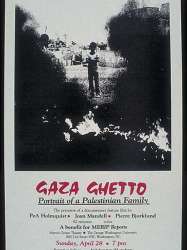The Ambassador est un film
The Ambassador (2005)

Si vous aimez ce film, faites-le savoir !
Durée 56minutes
Themes L'immigration, Documentaire sur le droit, Documentaire sur la guerre, Documentaire historique, Documentaire sur la politique, Politique, Les dictatures latino-américaines
Note54%










The Ambassador (Norwegian: Ambassadøren) is a 2005 Norwegian documentary film directed by Erling Borgen. It is a Norwegian production, produced by Erling Borgen for INSIGHT TV.
^ "The Ambassador (Ambassadøren)". nfi.no. Norwegian Film Institute. Retrieved 1 March 2014.
^ Grossman, Richard (January 2007). "The Ambassador by Erling Borgen". The Americas (Academy of American Franciscan History) 63 (3): 507–509. doi:10.1353/tam.2007.0017. Retrieved 1 March 2014.
^ "Les films - L’ambassadeur." [The Films - The Ambassador] (in French). Retrieved 1 March 2014.
Synopsis
The film examines the career of John Negroponte, focusing primarily on his time as U.S. Ambassador to Honduras in the early 1980s. It brings to light the militaristic aspects of his service in the region in relation to the Reagan Doctrine. Interviews with numerous Central American human rights activists point to Negroponte’s alleged complicity in war crimes not only in his nation of diplomatic assignment, but also in neighboring El Salvador as a part of the Salvadoran Civil War and in Nicaragua as an aid to the Contras. The documentary covers forced disappearance as part of this involvement including the disappearance of 179 Hondurans and specific examples such as the case of Father James Carney, whose brother is interviewed. The film also contains interviews with former U.S. Ambassador to Honduras Jack R. Binns, Negroponte’s predecessor; indigenous Guatemalan activist Rigoberta Menchú, and Salvadoran bishop Medardo Gomez.Commentaires
Postez un commentaire :
Suggestions de films similaires à The Ambassador
Il y a 8942 films qui ont les mêmes thèmes (dont 0 films qui ont les mêmes 7 thèmes que The Ambassador), pour avoir au final 70 suggestions de films similaires.Si vous avez aimé The Ambassador, vous aimerez sûrement les films similaires suivants :

El Salvador: Another Vietnam (1981)
, 53minutesOrigine Etats-Unis
Genres Documentaire
Thèmes La mer, Transport, Documentaire sur le droit, Documentaire sur la guerre, Documentaire historique, Documentaire sur la politique, Politique, Les dictatures latino-américaines
Acteurs Mike Farrell
Note64%





 , 52minutes
, 52minutesOrigine Algerie
Genres Documentaire
Thèmes Afrique post-coloniale, L'immigration, Documentaire sur le droit, Documentaire sur la guerre, Documentaire historique, Documentaire sur une personnalité, Documentaire sur la politique, Politique
En 1939, la fin de la guerre civile espagnole oblige des milliers d’hommes, de femmes et d’enfants à fuir l’Espagne franquiste. En Algérie, l’administration française ouvre des camps pour les accueillir. 70 après, un jeune Algérien enquête sur ces camps. Malgré l’absence d’archives, les traces ont survécu à l’oubli collectif et transparaissent dans l’Algérie d’aujourd’hui.

Origine Canada
Genres Documentaire
Thèmes La mer, Transport, Documentaire sur le droit, Documentaire sur la guerre, Documentaire historique, Documentaire sur la politique, Politique, Les dictatures latino-américaines

Google Darfur (2007)
, 1h37Origine Etats-Unis
Thèmes Afrique post-coloniale, L'immigration, Documentaire sur le droit, Documentaire sur la guerre, Documentaire historique, Documentaire sur une personnalité, Documentaire sur la politique, Politique

Em Busca de Iara (2013)
Origine Bresil
Genres Documentaire
Thèmes La mer, Transport, Documentaire sur le droit, Documentaire sur la guerre, Documentaire historique, Documentaire sur la politique, Politique, Les dictatures latino-américaines
Note79%






Darfur Now (2007)
, 1h38Réalisé par Ted Braun
Origine Etats-Unis
Genres Documentaire, Policier
Thèmes Afrique post-coloniale, L'immigration, Documentaire sur le droit, Documentaire sur la guerre, Documentaire historique, Documentaire sur une personnalité, Documentaire sur la politique, Politique
Acteurs Don Cheadle, George Clooney, Arnold Schwarzenegger
Note66%






Gaza Ghetto (1984)
Genres Documentaire
Thèmes Afrique post-coloniale, La famille, L'immigration, Religion, Documentaire sur le droit, Documentaire sur la guerre, Documentaire historique, Documentaire sur une personnalité, Documentaire sur la politique, Documentaire sur la religion, Politique, Religion juive
Note56%






Death in Gaza (2004)
, 1h20Réalisé par James Miller
Genres Documentaire
Thèmes Afrique post-coloniale, Religion, Documentaire sur le droit, Documentaire sur la guerre, Documentaire historique, Documentaire sur une personnalité, Documentaire sur la politique, Documentaire sur la religion, Politique, Religion juive
Acteurs James Miller, Saira Shah
Note79%






Fahrenheit 9/11 (2004)
, 1h57Réalisé par Michael Moore
Origine Etats-Unis
Genres Documentaire
Thèmes Les attentats du 11 septembre 2001, Religion, Le terrorisme, Transport, Aviation, Documentaire sur le droit, Documentaire sur la guerre, Documentaire historique, Documentaire sur la politique, Documentaire sur la religion, Documentaire sur les technologies, Documentaire sur le terrorisme, Politique, Religion musulmane, Dans un avion, Film catastrophe, Film de catastrophe aérienne, Détournement d'avion
Acteurs Michael Moore, Ben Affleck, Stevie Wonder, Larry King, Ricky Martin, Robert De Niro
Note74%





Ce documentaire s'attaque de plein fouet aux problèmes brûlants de l'Amérique. La caméra de Michael Moore filme avec scepticisme le Président George W. Bush et ses propres conseillers.Prenant pour point de départ l'élection controversée de 2000, le réalisateur retrace l'improbable ascension d'un médiocre pétrolier texan devenu maître du monde libre. Puis il ouvre la boîte de Pandore du Président et révèle les liens personnels et financiers qui unissent la famille Bush à celle de Ben Laden.Michael Moore y dénonce également les méfaits du Patriot Act et les souffrances provoquées par la guerre en Irak.

FahrenHYPE 9/11 (2004)
, 1h20Origine Etats-Unis
Genres Documentaire
Thèmes Les attentats du 11 septembre 2001, Religion, Le terrorisme, Transport, Aviation, Documentaire sur le droit, Documentaire sur la guerre, Documentaire historique, Documentaire sur la politique, Documentaire sur la religion, Documentaire sur les technologies, Documentaire sur le terrorisme, Politique, Religion musulmane, Dans un avion, Film catastrophe, Film de catastrophe aérienne, Détournement d'avion
Acteurs Ron Silver, Michael Moore
Note49%





 Connexion
Connexion